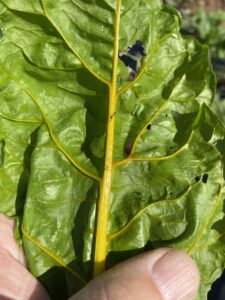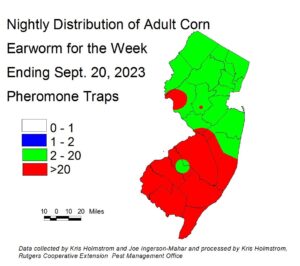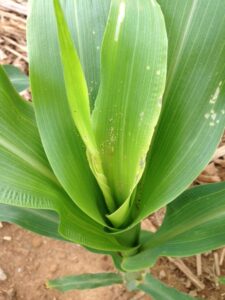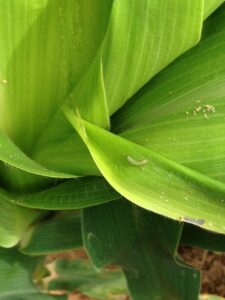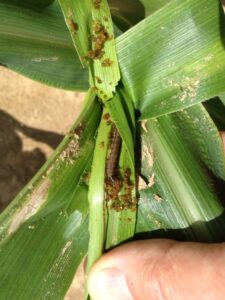Sweet Corn
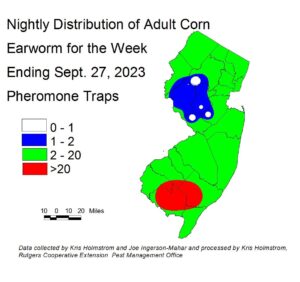 Northern and central blacklight traps and all pheromone traps continue to catch corn earworm (CEW) moths. However, the dramatic drop in nighttime temperatures following the tropical storm have significantly lowered catch numbers this week. Should temperatures moderate, we will know whether this indicates a reduced population or simply lower activity. Pheromone trap information is available from all northern and central sites, with now very limited input from southern New Jersey. We will use a combination of pheromone and blacklight trap types to derive silk spray schedules by region. We are now only able to check many traps on a weekly basis, as our student help has returned to their studies. This can give some areas an artificially high or low appearance of activity. Red areas on the pheromone trap map (at right) indicate a 3-day spray schedule. Green areas indicate a 4 day schedule. Silking corn is remains at risk of CEW infestation at this time. Be sure to access information from this publication in the upcoming weeks to determine how frequently you should treat silking sweet corn to protect it from CEW infestation.
Northern and central blacklight traps and all pheromone traps continue to catch corn earworm (CEW) moths. However, the dramatic drop in nighttime temperatures following the tropical storm have significantly lowered catch numbers this week. Should temperatures moderate, we will know whether this indicates a reduced population or simply lower activity. Pheromone trap information is available from all northern and central sites, with now very limited input from southern New Jersey. We will use a combination of pheromone and blacklight trap types to derive silk spray schedules by region. We are now only able to check many traps on a weekly basis, as our student help has returned to their studies. This can give some areas an artificially high or low appearance of activity. Red areas on the pheromone trap map (at right) indicate a 3-day spray schedule. Green areas indicate a 4 day schedule. Silking corn is remains at risk of CEW infestation at this time. Be sure to access information from this publication in the upcoming weeks to determine how frequently you should treat silking sweet corn to protect it from CEW infestation.
The highest nightly blacklight trap catches of CEW for the week ending 9/27/23 are as follows:
| Allamuchy 3 | Califon 1 | Oldwick 1 |
| Allentown 2 | Chester 1 | Princeton 1 |
| Milltown 2 | Clinton 1 | Sergeantsville 1 |
| Bellemeade 1 | New Egypt 1 | South Branch 1 |
The highest nightly pheromone trap catches of CEW for the week ending 9/27/23 are as follows:
| East Vineland 40 | Green Creek 4 | South Branch 2 |
| Georgetown 19 | Matawan 3 | Chester 1 |
| Farmingdale 14 | Califon 2 | Pennington 1 |
| Allamuchy 6 | Snyder Farm (Hunterdon) 2 | Sparta 1 |
Silking Spray Schedules*:
South – 3-4 days
Central – 4 days
North – 4 days
*These recommendations are based on regional catches. Adhere to tighter spray schedules if indicated by local trap catches. Synthetic pyrethroids alone should NOT be used for corn earworm (CEW) protection on silking corn, or for fall armyworm (FAW) management at any stage. Control with these materials is very inconsistent.
Cole Crops
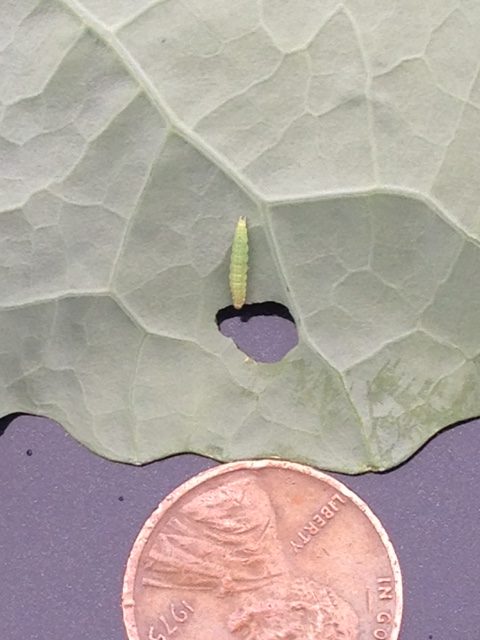 Fall plantings are now impacted by diamondback moth larvae ((DBM) see photo at right), as well as imported cabbage worm (ICW), cross striped cabbage worm (CSCW) and beet armyworm (BAW). DBM can multiply quickly, and does not respond to chlorantraniliprole (Coragen) in many parts of the state. Effective materials continue to be IRAC 5 materials (spinosyns), and the IRAC 6 material, ememectin benzoate (Proclaim). Consultants and scouts report good efficacy with the IRAC 21A, tolfenpyrad (Torac) . Be sure to check the Cole Crops Section of the 2022-23 Commercial Guide for specifics, as PHI’s and crop labels vary. It is important to return to treated fields within 2-3 days to assess the efficacy of the insecticide applications. Effective materials should eliminate DBM larvae within 48 hours. BAW will not be controlled by pyrethroids. ICW and CSCW have not shown resistance to labeled materials in our area.
Fall plantings are now impacted by diamondback moth larvae ((DBM) see photo at right), as well as imported cabbage worm (ICW), cross striped cabbage worm (CSCW) and beet armyworm (BAW). DBM can multiply quickly, and does not respond to chlorantraniliprole (Coragen) in many parts of the state. Effective materials continue to be IRAC 5 materials (spinosyns), and the IRAC 6 material, ememectin benzoate (Proclaim). Consultants and scouts report good efficacy with the IRAC 21A, tolfenpyrad (Torac) . Be sure to check the Cole Crops Section of the 2022-23 Commercial Guide for specifics, as PHI’s and crop labels vary. It is important to return to treated fields within 2-3 days to assess the efficacy of the insecticide applications. Effective materials should eliminate DBM larvae within 48 hours. BAW will not be controlled by pyrethroids. ICW and CSCW have not shown resistance to labeled materials in our area.
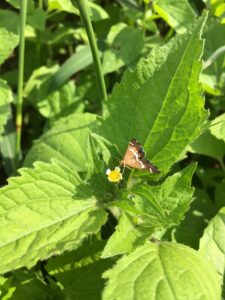 Hawaiian beet webworm (HBWW) continues to impact crops. Large numbers of moths may be found in weedy areas adjacent to host crops (photo at left). Galinsoga and pigweed patches seem to be favored by the moths. Injury to host crops (beet greens, swiss chard, spinach) has been reported from many parts of the state. Growers in all counties would be wise to check plantings of these hosts at least weekly for the presence of foliar injury. Numerous holes in leaves, with larvae on the lower leaf surfaces (photo at right). Recommended insecticides may be found in the Spinach Section of the 2022-23 Commercial Guide.
Hawaiian beet webworm (HBWW) continues to impact crops. Large numbers of moths may be found in weedy areas adjacent to host crops (photo at left). Galinsoga and pigweed patches seem to be favored by the moths. Injury to host crops (beet greens, swiss chard, spinach) has been reported from many parts of the state. Growers in all counties would be wise to check plantings of these hosts at least weekly for the presence of foliar injury. Numerous holes in leaves, with larvae on the lower leaf surfaces (photo at right). Recommended insecticides may be found in the Spinach Section of the 2022-23 Commercial Guide.
Pepper Weevil
Pepper weevil infestations appear to be down for NJ growers this year. As of this writing, only two farms are, or have been infested, both in the Vineland – East Vineland area. Given the time of year and cooling weather, pepper weevil will become less of a problem. Continue to look for small, aborted fruit, cutting them open to examine the interior for feeding damage or small grey-white grubs. Vydate (IRAC 1A) appears to be one of the better materials for trying to manage weevils, along with Actara (IRAC 4A). Never rely upon pyrethroids alone to manage weevils.
Beet Armyworm
Pheromone catches of beet armyworm are high in some southern NJ areas at this time. 65 moths per night in East Vineland have been reported. 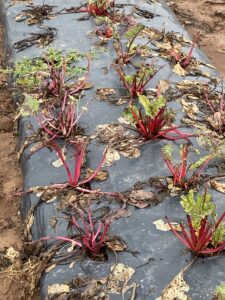
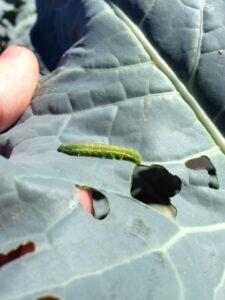 Additionally, BAW larvae have been found in cole crop plantings northward to Hunterdon County this week. While numbers are not high in these areas, their presence points to possible higher infestations in southern parts of the state. This pest (photo at near left) has the ability to defoliate pepper plants and damage fruit, and can cause severe damage on other crops (see photo of chard at far left). BAW is resistant to pyrethroid insecticides, and other materials should be used in response to infestations. Effective materials include spinosyns (IRAC 5) and diamides (IRAC 28).
Additionally, BAW larvae have been found in cole crop plantings northward to Hunterdon County this week. While numbers are not high in these areas, their presence points to possible higher infestations in southern parts of the state. This pest (photo at near left) has the ability to defoliate pepper plants and damage fruit, and can cause severe damage on other crops (see photo of chard at far left). BAW is resistant to pyrethroid insecticides, and other materials should be used in response to infestations. Effective materials include spinosyns (IRAC 5) and diamides (IRAC 28).
 Articles in this section contain information helpful to the NJ commercial organic grower.
Articles in this section contain information helpful to the NJ commercial organic grower.
